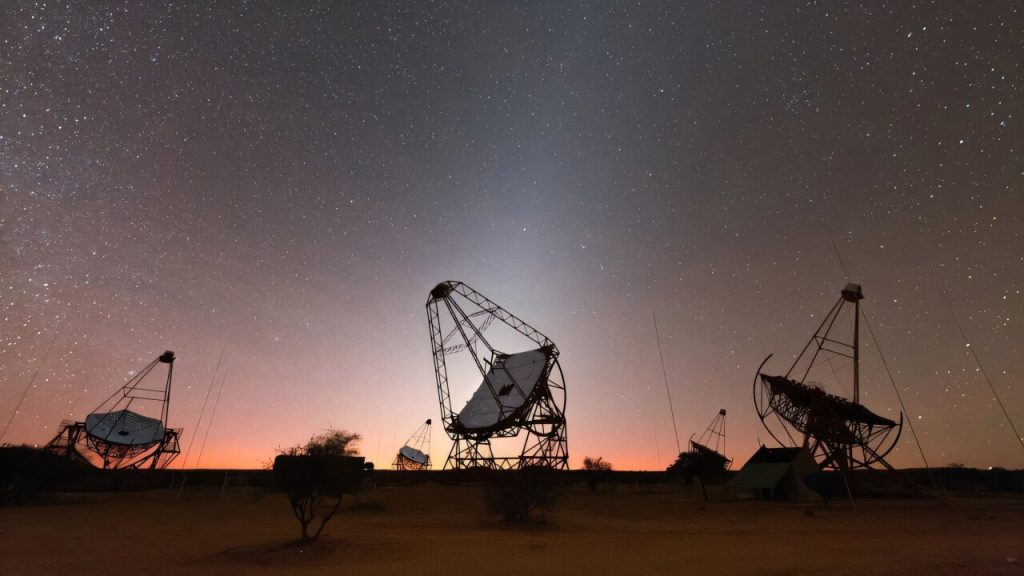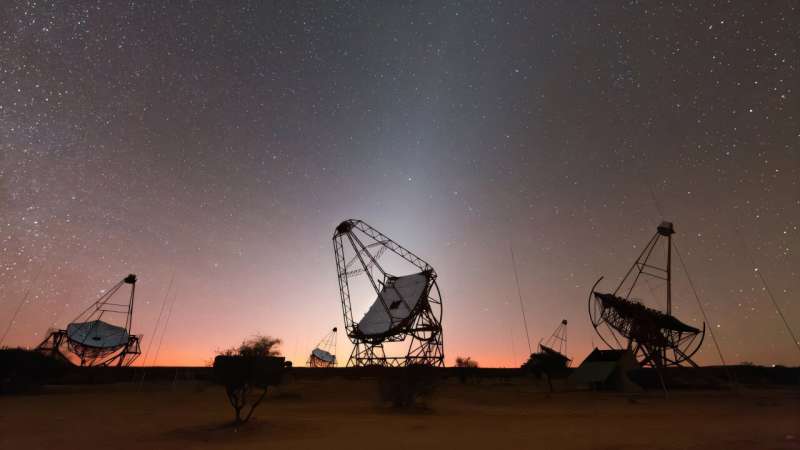
Astronomers measure cosmic electrons at the highest energies to date (Image Credit: Phys.org)

Five telescopes of the H.E.S.S.-collaboration in Namibia are used to study cosmic radiation, especially gamma radiation. With data from 10 years of observations, researchers have now been able to detect cosmic electrons and positrons with an unprecedented energy of more than 10 tera-electronvolts.
Since charged particles are deflected in all directions by the magnetic fields in our cosmic neighborhood, it is difficult to determine their origin. This time, however, the outstanding quality of the measured particle energy spectrum up to the highest energy values opens up new possibilities: The scientists suspect that a pulsar, which may be no more than a few thousand light-years away, could be the source.
The universe hosts extreme environments, from the coldest temperatures to the most energetic sources. Extreme objects such as supernova remnants, pulsars or active galactic nuclei produce charged particles and gamma radiation with energies far above those reached in thermal processes such as nuclear fusion in stars.
While the emitted gamma-rays cross space undisturbed, the charged particles—or cosmic rays—are deflected by the omnipresent magnetic fields in the universe and reach Earth isotropically from all directions. This means that researchers cannot directly deduce the origin of the radiation.
In addition, charged particles lose energy through interactions with light and magnetic fields. These losses are particularly strong for the most energetic electrons and positrons (positively charged anti-particles of the electron) with energies above the tera-electronvolt mark.
When instruments on Earth measure charged cosmic particles of such high energies, it means that they cannot have traveled far. This points to the existence of powerful natural particle accelerators near our solar system.
A kink in the spectrum reveals the origin
In a new analysis, scientists from the H.E.S.S. collaboration have for the first time narrowed down where these cosmic particles come from. The starting point of the analysis is the measurement of the spectrum of cosmic rays, i.e., the energy distribution of the measured electrons and positrons. The analysis is based on 10 years of observations, which guarantees high data quality. The integrated electron spectrum extends up to several tens of tera-electronvolts.
The paper is published in the journal Physical Review Letters.
“Our measurement does not only provide data in a crucial and previously unexplored energy range, impacting our understanding of the local neighborhood, but it is also likely to remain a benchmark for the coming years,” says Werner Hofmann of the Max Planck Institute for Nuclear Physics in Heidelberg.
In the spectrum, which is characterized by comparatively small error bars at TeV energies, a prominent kink at around one tera-electronvolt is striking. Both above and below this break, the spectrum follows a power law without any further anomalies.
Straying through the galaxy
To find out which astrophysical process has accelerated the electrons to such high energies and what the origin of the kink is, the researchers compared this data with model predictions. Source candidates are pulsars, which are stellar remnants with strong magnetic fields. Some pulsars blow a wind of charged particles into their surroundings, and the magnetic shock front of this wind could be the place where the particles experience a boost.
Discover the latest in science, tech, and space with over 100,000 subscribers who rely on Phys.org for daily insights.
Sign up for our free newsletter and get updates on breakthroughs,
innovations, and research that matter—daily or weekly.
The same applies to shock fronts of supernova remnants. Computer models show that electrons accelerated in this way travel into space with a certain energy distribution. These models track the electrons and positrons as they move through the Milky Way and calculate how their energy changes as they interact with magnetic fields and light in the Milky Way.
In the process, the particles lose so much energy that their original energy spectrum is distorted. In the final step, astrophysicists try to fit their model to the data in order to learn more about the nature of the astrophysical sources.
But what object has hurled the electrons into space that the telescopes have measured? The particle spectrum with energies below one tera-electronvolt probably consists of electrons and positrons from different pulsars or supernova remnants.
At higher energies, however, a different picture emerges: the energy spectrum drops steeply from about one teraelectronvolt. This is also confirmed by models that study the particles accelerated by astronomical sources and their diffusion through the galactic magnetic field. This transition at one tera-electronvolt is particularly pronounced and exceptionally sharp.
“This is an important result, as we can conclude that the measured electrons most likely originate from very few sources in the vicinity of our own solar system, up to a maximum of a few thousand light years away,” says Kathrin Egberts of the University of Potsdam. This distance is relatively small compared to the size of the Milky Way.
“Sources at different distances would wash out this kink considerably,” Egberts continues.
According to Hofmann, even a single pulsar could be responsible for the electron spectrum at high energies. However, it is not clear which one that is. Since the source must be very close by, only a few pulsars come into question.
More information:
F. Aharonian et al, High-Statistics Measurement of the Cosmic-Ray Electron Spectrum with H.E.S.S., Physical Review Letters (2024). DOI: 10.1103/PhysRevLett.133.221001. On arXiv: DOI: 10.48550/arxiv.2411.08189
Journal information:
Physical Review Letters
,
arXiv
Provided by
Max Planck Society
Astronomers measure cosmic electrons at the highest energies to date (2024, November 25)
retrieved 26 November 2024
from https://phys.org/news/2024-11-astronomers-cosmic-electrons-highest-energies.html
part may be reproduced without the written permission. The content is provided for information purposes only.








